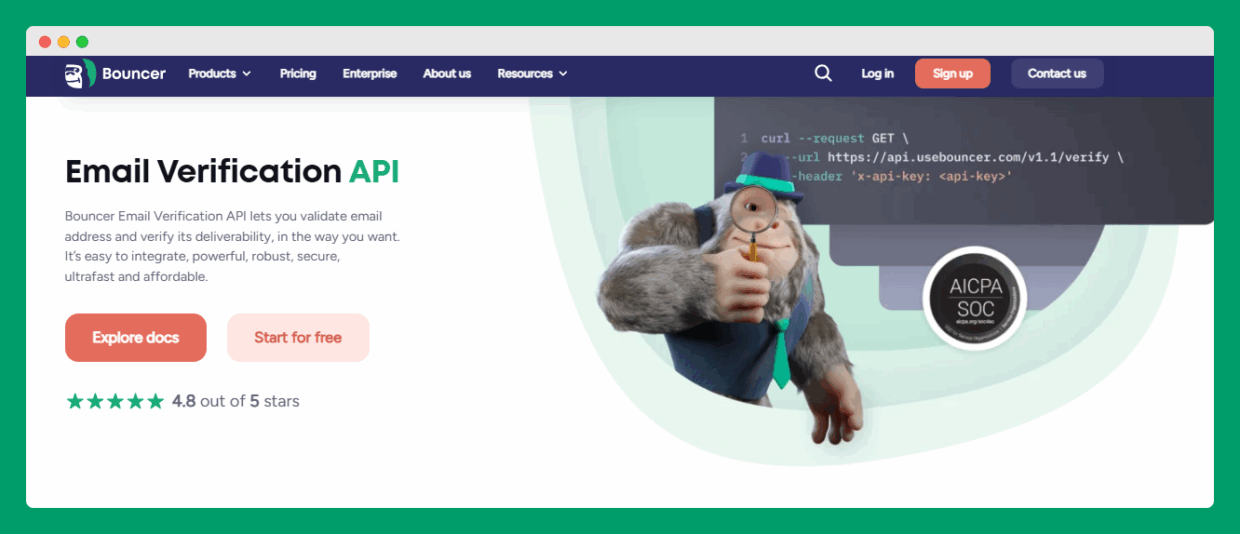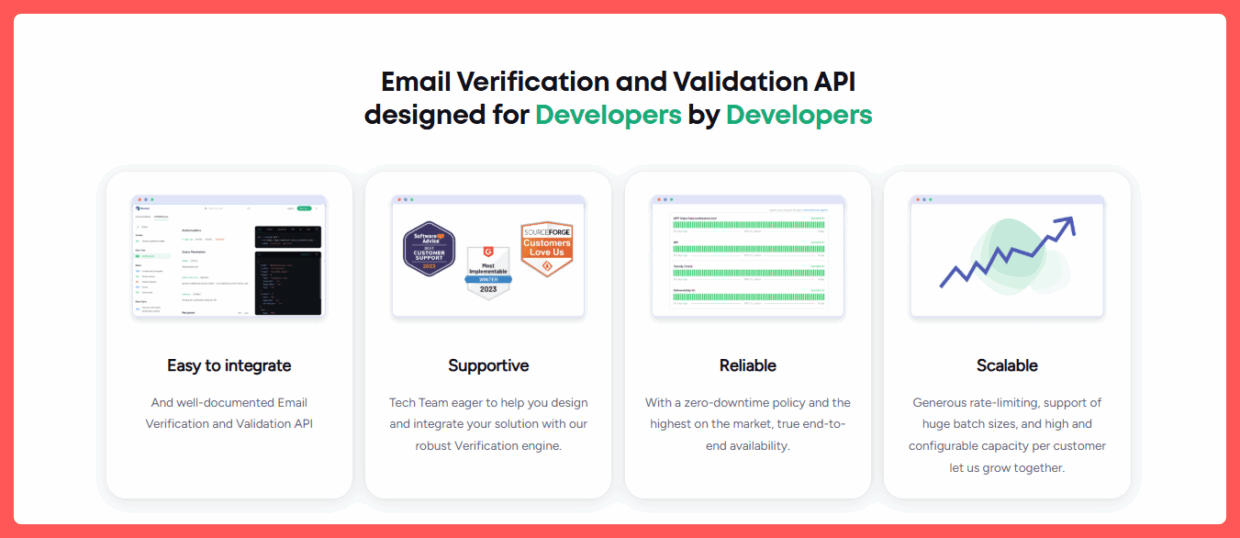That’s why more teams are looking for a reliable email verification API – a tool that can quietly check every address in real time or run batch verification before a big send.
Among the many names in the market, Bouncer shines like no other. It’s trusted for speed, accuracy, and the ability to catch everything from typos and non existent domains to disposable accounts from free providers like Gmail or Yahoo.
In this article, we’ll break down how Bouncer’s API works, why disposable emails are a problem, and how businesses use it to keep a clean email list, protect inbox placement, and improve campaign performance.
How Bouncer’s email validation API works
Think about how many people type too fast on web forms. A missing letter, a misplaced dot, or a fake Gmail account sneaks into your database. That’s how bad emails slip in, and it’s where Bouncer’s email verification API steps in.
The API works in two modes: real time email verification and batch verification.
In real time, it sits behind your landing pages or sign-up site and checks every new account request as it comes in. One wrong character in var email, a non existent domain, or a disposable account from free email providers gets flagged instantly.
With batch verification, you can upload a file with thousands of addresses and run bulk checks before a major send. Both methods use API calls to ping mailbox providers like Gmail, Yahoo, or niche free providers, and then return a clear response – valid, invalid, or risky.
Bouncer’s system also identifies common traps. It looks for syntax errors, spots typos, and even tests deliverability against database records. The result is a clean email list with fewer false positives and fewer bad emails clogging your campaigns.
And here’s why this matters: over 40% of organizations do not verify new sign-ups in real time, exposing them to invalid or disposable addresses. That’s almost half the market letting bad data slip straight into their client files. Thanks to integrating Bouncer’s email API key into your code, you cut this risk from the start and keep your messages reaching real inboxes.

Why disposable email addresses are a problem
Disposable emails are like shadows in your database. They look real at first glance, but once your messages hit them, they disappear without a trace.
For marketing teams and SaaS businesses, this creates wasted API calls, distorted open rates, and false signals about campaign success. A high number of non existent or short-lived accounts also damages your sender reputation with mailbox providers such as Gmail or Yahoo.
The bigger risk sits in data quality.
According to research, only about 62% of submitted email addresses are valid, underscoring the critical need for list hygiene. That means almost four out of ten addresses in a typical file can be bad emails, fake accounts, or temporary inboxes. For a client running paid ads, every disposable account captured through web forms equals wasted spend and lost reporting accuracy.
This is where Bouncer’s email verification API plays its role.
- It identifies free providers commonly used for disposable accounts, checks quality score for each address, and flags addresses that don’t belong in a clean email list.
- During real time email verification, these entries are stopped before they enter your database.
- In batch verification, the same detection rules apply across large sets of data, catching junk in bulk.
- With Bouncer integrated into your site or landing pages, disposable emails never get the chance to pollute your database or mislead your team’s decisions.

Bulk email verification made easy
Every business with a growing database faces the same challenge: contact lists decay fast.
Staff changes, abandoned accounts, or typing mistakes add up. In fact, list cleaning matters: almost 22-30% of contact lists decay annually, with ~3-4% lost monthly if no maintenance occurs. Without a process, your marketing campaigns end up chasing bad emails, hurting open rates and damaging trust with mailbox providers.
Bouncer addresses this through its batch verification system.
You upload a file with thousands, or even hundreds of thousands, of addresses. The API processes them at speed, with batch sizes reaching up to half a million. Each email gets a validation check, and the response shows if it is valid, invalid, non existent, or risky. This keeps your clean email list ready for the next send.
What makes this useful is how well Bouncer fits into daily operations.
- The batch API integrates directly with CRMs, marketing platforms, and email service clients.
- Instead of exporting data, running checks manually, and re-importing, you can connect Bouncer to your account and run checks from inside the same site where your campaigns live.
- Whether you run automated workflows, landing pages, or newsletters, the integration keeps your data fresh.
- Thanks to identifying bad actors and clearing false entries, Bouncer helps businesses maintain accuracy before any messages leave the server.
Email validation for better email deliverability
Inbox placement is fragile. A single invalid email address or spam trap can drag down results for an entire campaign. A mere 1% increase in invalid or spam-trap addresses can suppress your inbox placement by up to 10%. That’s a steep price for overlooking list hygiene.
The reality is tough: in 2024, the average email deliverability rate hovered around 83.1%, meaning nearly one in six marketing emails never reached the inbox. With numbers like that, every clean email list becomes an asset.
Validation through Bouncer’s email verification API filters out bad emails, reduces bounce rate, and signals to mailbox providers like Gmail or Yahoo that your messages deserve trust. The result is stronger sender reputation and more campaigns reaching real clients instead of disappearing into spam folders.
Understanding API usage in Bouncer
Working with Bouncer’s email verification API starts with the basics: API key, endpoints, and credits.
Developers call the service through simple requests, either for real time email verification on web forms or for batch verification on large files.
Each request consumes credits, which are linked to the account, making usage easy to track across teams or clients.
The response from the API includes validation status, quality score, and extra data points that help identify risky or non existent addresses.
Bouncer also sets clear rate limits to keep performance stable.
- For real time checks, the API can handle up to 1,000 requests per minute.
- For batch operations, the limit sits at 200 requests per minute, with batch sizes reaching up to 500,000 addresses.
This makes it practical for both landing pages capturing leads and enterprise sites managing millions of records in a database.
Pricing is flexible, with options scaled for startups running smaller campaigns and for enterprises handling millions of messages. Businesses can start with pay-as-you-go credits and grow into higher-volume packages as their email programs expand. This model keeps costs aligned with usage while still giving access to the same robust validation engine.

Comparing email API vs full platform
Bouncer gives two paths: direct email verification API or the full dashboard with extra tools.
Developers often lean toward the API, embedding verification directly into web forms, landing pages, or internal code. It lets them validate addresses in real time, cut bad emails before they touch the database, and run batch verification through API calls without leaving their site.
Marketers, on the other hand, may prefer the dashboard. It brings integrations with CRMs, file uploads, reporting, and user management. The dashboard is less about coding and more about daily workflows.
Yet the real strength comes from automation. Automated emails outperform batch sends: ~52% higher opens, 332% more clicks, and 2,361% better conversions.
That’s why many teams mix both: developers set up the API for speed and precision, while marketers use the platform for strategy and reporting.
Bouncer as your email validator
Accuracy is the core of Bouncer’s promise.
The system checks each account across mailbox providers, identifies false or non existent entries, and delivers a clear quality score.
With less than 2% unknown results reported and coverage across even complex setups like catch-all domains, Bouncer is built for reliability.
Security matters too.
- Data is stored in European AWS centers, and every API key request runs with GDPR compliance in mind.
- Multi-factor authentication, IP filtering, and permanent deletion options give clients control over where and how data is processed.
Keeping your email list healthy
Databases look stable on the surface, but behind the scenes, they shrink every month. Staff turnover and typing mistakes eat away at them. Email lists regularly lose about 25.7% annually to decay, which significantly impacts reach. That’s one in four contacts gone in a year if no checks are in place.
Bouncer’s email verification API helps stop this decline.
Automated verification keeps the database fresh by spotting old or non existent entries before they make it into campaigns. A batch verification run before a big send clears out invalid email addresses, while real time email verification on web forms catches mistakes at sign-up.
Together, these practices keep the list clean, protect open rates, and prevent wasted messages.
How Bouncer protects against bad actors
Not every invalid entry is a typo. Some emails are built to trap senders or mislead systems. Role-based addresses like info@ or sales@ rarely link to a single client and often inflate bounce rates. Spam-trap accounts can even harm your domain reputation if hit repeatedly.
Bouncer adds extra layers of protection against these threats.
Its system can:
- identify disposable accounts from free providers,
- detect spam traps,
- and flag risky data before it poisons campaigns.
Automated hygiene processes, like removing hard bounces or role-based addresses, cut bounce rates by up to 50%. By filtering bad emails early, the API keeps your messages safe, your sender reputation strong, and your campaigns focused on real people instead of false signals.
Reviews: what users say about Bouncer’s handling of email addresses

Royce G., VP – Sales & Marketing (May 2025): “Integration was straightforward, allowing us to implement real-time verification via API seamlessly into our existing workflows.”
Yaroslav, Lead Generation Manager (July 2025): “Clean, easy interface & integrations — Drag-and-drop CSVs or use the API; it plugs right into my outreach workflow without headaches.”
Verified User in Wholesale (May 2025): “Its API is easy to hook up, with clear docs that let us integrate it in no time. The score-based system… gives us a better idea of which addresses might bounce or cause issues.”
Michael A., CTO (May 2025): “Extremely easy to integrate using provided API documentation and examples.”
Verified User in Computer Software (May 2025): “Life time credits, accurate result and a simple to use API helped us integrate Bouncer in our sales pipeline.”
Cezar F. (April 2024): “API integrations was super easy to implement. API is also providing useful info to know the type of an email address.”
Rami K. (April 2024): “Great UX, fast and easy to use whether through api or manually on portal.”
Sergio D. (April 2024): “Access to a simple API with service stability.”
Mike P., Technical Director (Oct 2022): “The bouncer API is really simple to get started with, and we were able to integrate it and begin verifying our email addresses within a very short space of time.”
Ready to clean up your email list?
Bad emails cost you money, time, and trust with mailbox providers.
With Bouncer’s email verification API, you can validate addresses in real time, run batch verification on files, and keep your database healthy before the next campaign.
Start for free today or book a demo, and keep your messages landing in the inbox.


